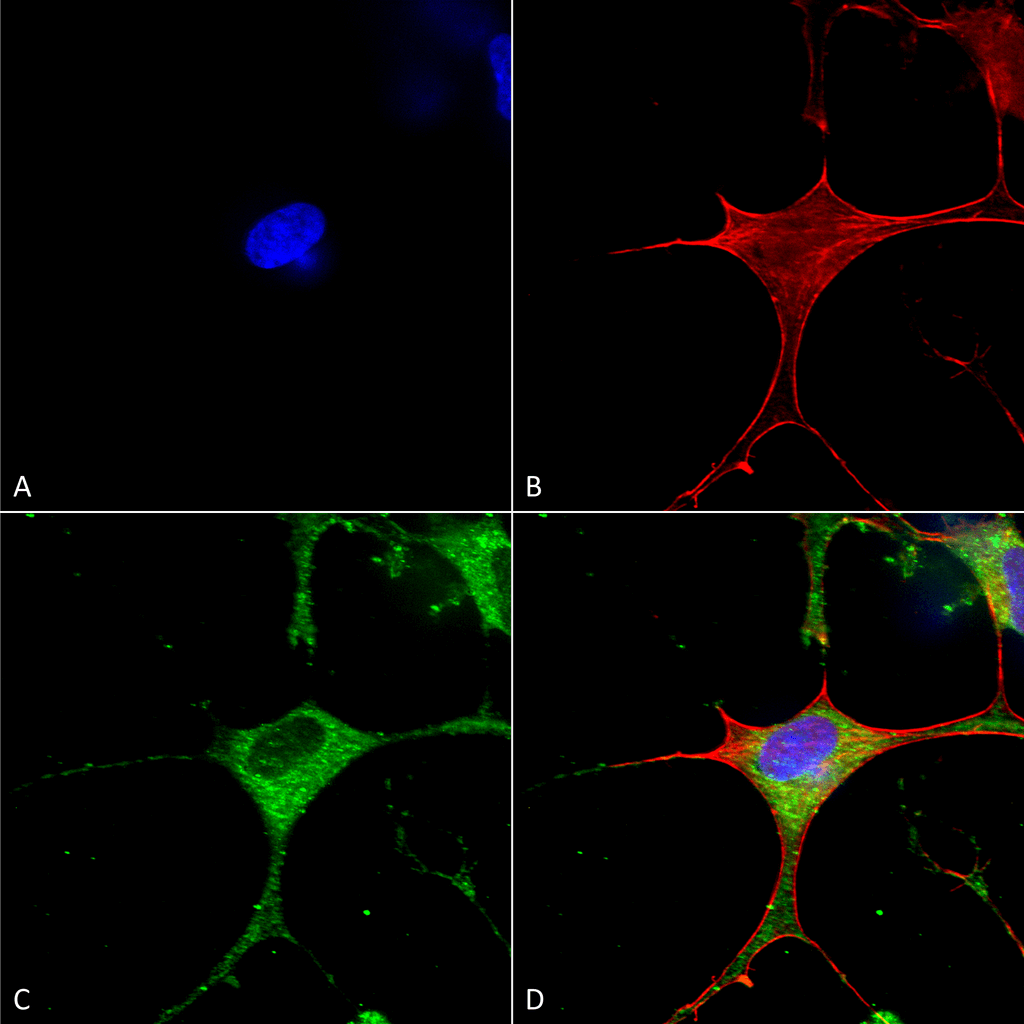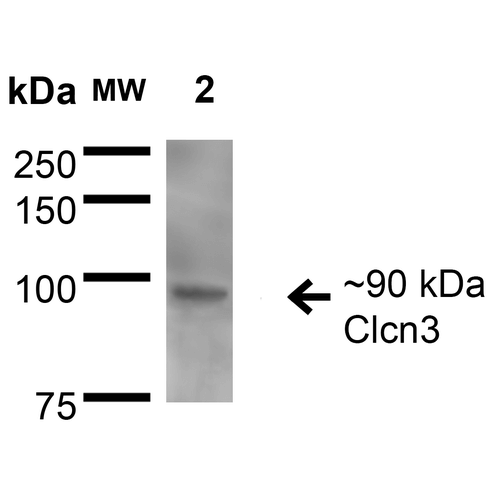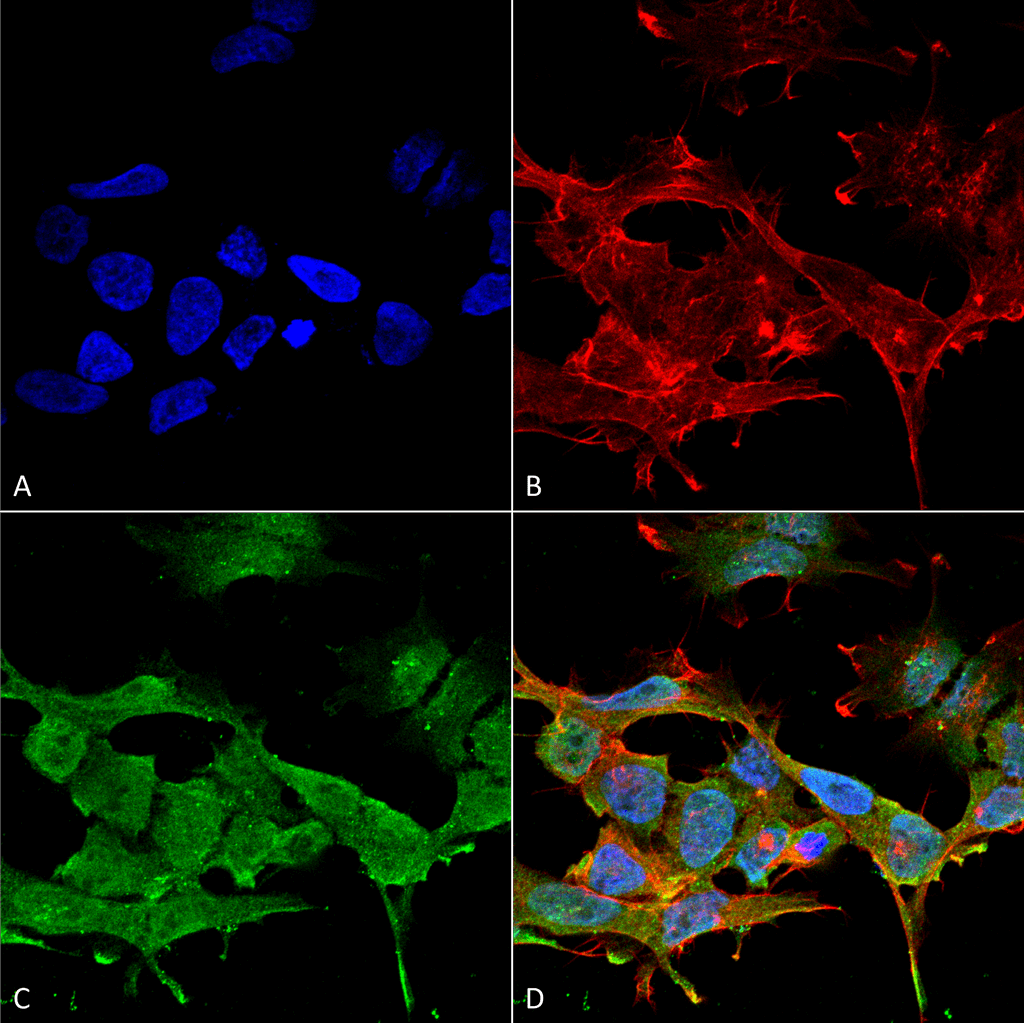Anti-Chloride Channel Protein 3 (Clcn3) Antibody (11566)
Anti-Chloride Channel Protein 3 (Clcn3) Antibody (11566)
Product No.: 11566
- -
- -
Clone S258-5 Target Chloride Channel Protein 3 (Clcn3) Formats AvailableView All Product Type Monoclonal Alternate Names Chloride channel protein 3, ClC-3, Chloride transporter ClC-3 Isotype Mouse IgG1 Applications ICC , IF , IHC , WB |
Data
 Immunocytochemistry/Immunofluorescence analysis using Mouse Anti-Clcn3 Monoclonal Antibody, Clone S258-5 (11566). Tissue: Neuroblastoma cells (SH-SY5Y). Species: Human. Fixation: 4% PFA for 15 min. Primary Antibody: Mouse Anti-Clcn3 Monoclonal Antibody (11566) at 1:50 for overnight at 4°C with slow rocking. Secondary Antibody: AlexaFluor 488 at 1:1000 for 1 hour at RT. Counterstain: Phalloidin-iFluor 647 (red) F-Actin stain; Hoechst (blue) nuclear stain at 1:800, 1.6mM for 20 min at RT. (A) Hoechst (blue) nuclear stain. (B) Phalloidin-iFluor 647 (red) F-Actin stain. (C) Clcn3 Antibody (D) Composite.
Immunocytochemistry/Immunofluorescence analysis using Mouse Anti-Clcn3 Monoclonal Antibody, Clone S258-5 (11566). Tissue: Neuroblastoma cells (SH-SY5Y). Species: Human. Fixation: 4% PFA for 15 min. Primary Antibody: Mouse Anti-Clcn3 Monoclonal Antibody (11566) at 1:50 for overnight at 4°C with slow rocking. Secondary Antibody: AlexaFluor 488 at 1:1000 for 1 hour at RT. Counterstain: Phalloidin-iFluor 647 (red) F-Actin stain; Hoechst (blue) nuclear stain at 1:800, 1.6mM for 20 min at RT. (A) Hoechst (blue) nuclear stain. (B) Phalloidin-iFluor 647 (red) F-Actin stain. (C) Clcn3 Antibody (D) Composite. Western Blot analysis of Rat Brain Membrane showing detection of ~90 kDa CIcn3 protein using Mouse Anti-CIcn3 Monoclonal Antibody, Clone S258-5 (11566). Lane 1: Molecular Weight Ladder. Lane 2: Rat Brain Membrane. Load: 15 µg. Block: 2% BSA and 2% Skim Milk in 1X TBST. Primary Antibody: Mouse Anti-CIcn3 Monoclonal Antibody (11566) at 1:200 for 16 hours at 4°C. Secondary Antibody: Goat Anti-Mouse IgG: HRP at 1:1000 for 1 hour RT. Color Development: ECL solution for 6 min in RT. Predicted/Observed Size: ~90 kDa.
Western Blot analysis of Rat Brain Membrane showing detection of ~90 kDa CIcn3 protein using Mouse Anti-CIcn3 Monoclonal Antibody, Clone S258-5 (11566). Lane 1: Molecular Weight Ladder. Lane 2: Rat Brain Membrane. Load: 15 µg. Block: 2% BSA and 2% Skim Milk in 1X TBST. Primary Antibody: Mouse Anti-CIcn3 Monoclonal Antibody (11566) at 1:200 for 16 hours at 4°C. Secondary Antibody: Goat Anti-Mouse IgG: HRP at 1:1000 for 1 hour RT. Color Development: ECL solution for 6 min in RT. Predicted/Observed Size: ~90 kDa. Immunocytochemistry/Immunofluorescence analysis using Mouse Anti-Clcn3 Monoclonal Antibody, Clone S258-5 (11566). Tissue: Neuroblastoma cell line (SK-N-BE). Species: Human. Fixation: 4% Formaldehyde for 15 min at RT. Primary Antibody: Mouse Anti-Clcn3 Monoclonal Antibody (11566) at 1:100 for 60 min at RT. Secondary Antibody: Goat Anti-Mouse ATTO 488 at 1:100 for 60 min at RT. Counterstain: Phalloidin Texas Red F-Actin stain; DAPI (blue) nuclear stain at 1:1000, 1:5000 for 60min RT, 5min RT. Localization: Membrane, Endosome, Endosome membrane, Cytoplasmic Vesicle, Secretory Vesicle Membrane. Magnification: 60X. (A) DAPI (blue) nuclear stain. (B) Phalloidin Texas Red F-Actin stain. (C) Clcn3 Antibody. (D) Composite.
Immunocytochemistry/Immunofluorescence analysis using Mouse Anti-Clcn3 Monoclonal Antibody, Clone S258-5 (11566). Tissue: Neuroblastoma cell line (SK-N-BE). Species: Human. Fixation: 4% Formaldehyde for 15 min at RT. Primary Antibody: Mouse Anti-Clcn3 Monoclonal Antibody (11566) at 1:100 for 60 min at RT. Secondary Antibody: Goat Anti-Mouse ATTO 488 at 1:100 for 60 min at RT. Counterstain: Phalloidin Texas Red F-Actin stain; DAPI (blue) nuclear stain at 1:1000, 1:5000 for 60min RT, 5min RT. Localization: Membrane, Endosome, Endosome membrane, Cytoplasmic Vesicle, Secretory Vesicle Membrane. Magnification: 60X. (A) DAPI (blue) nuclear stain. (B) Phalloidin Texas Red F-Actin stain. (C) Clcn3 Antibody. (D) Composite. - -
- -
Antibody DetailsProduct DetailsReactivity Species Human ⋅ Mouse ⋅ Rat Host Species Mouse Immunogen Synthetic peptide corresponding to aa 98-115 (cytoplasmic N-terminus) of rat Clcn3 (accession no. NP_445815.2). Product Concentration Lot Specific Formulation PBS, pH 7.4; 50% glycerol, 0.09% sodium azide. State of Matter Liquid Product Preparation Purified by Protein G affinity chromatography Storage and Handling This antibody is stable for at least one (1) year at -20°C. Avoid repeated freeze-thaw cycles. Regulatory Status For in vitro investigational use only. Not for use in therapeutic or diagnostic procedures. Country of Origin USA Shipping Next Day 2-8°C Applications and Recommended Usage? Quality Tested by Leinco Immunoblotting: use at 1-2ug/mL. A band of ~90kDa is detected.
Immunohistochemistry: use at 1-10ug/mL. These are recommended concentrations. User should determine optimal concentrations for their application. Positive control: Rat brain membranes. Each investigator should determine their own optimal working dilution for specific applications. See directions on lot specific datasheets, as information may periodically change. DescriptionSpecificity This antibody recognizes human, mouse,
and rat Clcn3. It does not cross-react with
Clcn4 or Clcn5. Background Ion channels are integral membrane proteins that help establish and control the small voltage gradient across the plasma membrane of living cells by allowing the flow of ions down their electrochemical gradient. Clcn3 mediates the exchange of chloride ions against protons and functions as an antiporter, contributing to the acidification of the endosome and synaptic vesicle lumen. It may play an important role in neuronal cell function through regulation of membrane excitability by protein kinase C. Antigen DetailsFunction [Isoform 1]: Strongly outwardly rectifying, electrogenic H(+)/Cl(-)exchanger which mediates the exchange of chloride ions against protons (PubMed:10915634). The CLC channel family contains both chloride channels and proton-coupled anion transporters that exchange chloride or another anion for protons (By similarity). The presence of conserved gating glutamate residues is typical for family members that function as antiporters (By similarity). {UniProtKB:P51790, PubMed:10915634}.; [Isoform 2]: Strongly outwardly rectifying, electrogenic H(+)/Cl(-)exchanger which mediates the exchange of chloride ions against protons (PubMed:10915634). May play an important role in neuronal cell function through regulation of membrane excitability by protein kinase C (PubMed:8155321). It could help neuronal cells to establish short-term memory (PubMed:8155321). {PubMed:10915634, PubMed:8155321}. NCBI Gene Bank ID UniProt.org Research Area Ion Channels References & CitationsTechnical Protocols |


